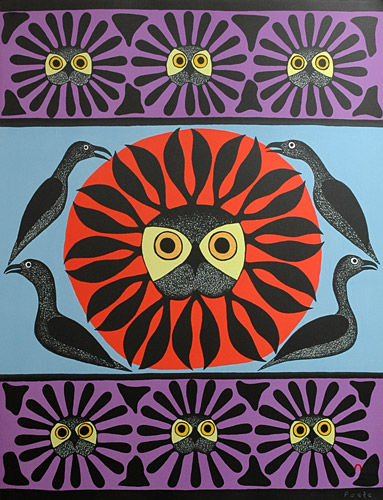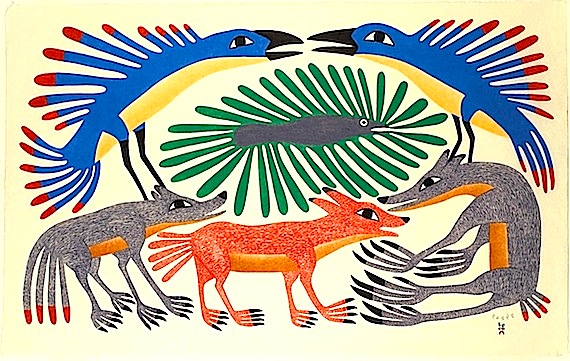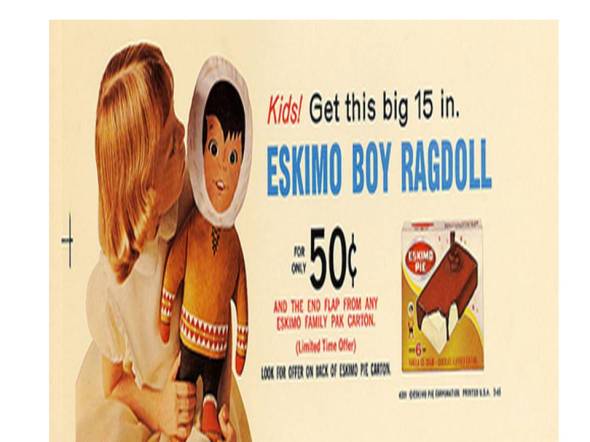ᕿᓐᓄᐊᔪᐊᖅ ᐋᓯᕙᒃ / Kenojuak Ashevak: Inuit Artist Pioneer
Posted: January 8, 2014 Filed under: English, IMAGES, Inuktitut Comments Off on ᕿᓐᓄᐊᔪᐊᖅ ᐋᓯᕙᒃ / Kenojuak Ashevak: Inuit Artist Pioneerᕿᓐᓄᐊᔪᐊᖅ ᐋᓯᕙᒃ (1927-2013)
Kenojuak Ashevak was born in 1927 at the Inuit camp of Ikirasaq on Baffin Island in the North West Territories of Canada. She died exactly one year ago today – January 8th – and we are honouring her now, one year later, because ZP did not ‘post’ during the month of January 2013.
.
One of the first women to make drawings in Cape Dorset during the 1950s, Kenojuak used graphite, coloured pencils and felt-tip pens. With the assistance of Inuit art promoter James Houston, Kenojuak made the transition to soapstone-cut print-making. Her first such print dates from 1959 and is called Rabbit Eating Seaweed. It is based on a needle-work and appliqué design she had made on a sealskin bag. Kenojuak would draw freely, with confidence in line and form, then would have her drawings transferred/cut into the print stones by one of the stone-cutters at the new West Baffin Eskimo Co-operative Workshop (“Senlavik”) which started up in 1959. After the stone-cutter had completed his incisions she would then apply one or two colours of inks to the printing surface. Sometimes the strong arms of Eegyvudluk Pootoogook would help apply the right paper-upon-stone pressure to complete the print. Kenojuak’s The Enchanted Owl, from 1960, is one of the most famous Canadian artworks internationally – instantly recognizable and emblematic of the 1960s and an “Idea” of The North.
.
Kenojuak was married three times and bore eleven children by her first husband, a hunter named Johnniebo Ashevak (1923-1972). At the time of her death from lung cancer in 2013, she was living in a wood-frame house in Kinngait (formerly Cape Dorset), Nunavut. A cheerful personality, Kenojuak was always humble about her artistic success, and thankful for the “gift” of her talent.

The sealskin bag made by Kenojuak in 1958 and from which she drew the inspiration for her first print_Rabbit Eating Seaweed
. . . . .
“Yeah Bro, I should say we do have Eskimo Lies”: the poetry of Inuit writer Norma Dunning
Posted: April 25, 2013 Filed under: English, Inuktitut, Norma Dunning Comments Off on “Yeah Bro, I should say we do have Eskimo Lies”: the poetry of Inuit writer Norma Dunning.
Eskimo Pie I
.
Found on Wikipedia under “Eskimo Pie”:
.
My response to the ad:
.
YEAH BRO
I should say we do have
ESKIMO LIES
Not only in N. Canada and
Urban centers, but in
combina-
tions of all flavors.
Eskimo Lies is a
sugercoated
conception of Northern
Peoples
Handled at Our
GOVERNMENT OFFICES
and by our general public
LIBERALS, PCs, RCMP
& THE
ACADEMY
NO SENSE
Buy Eskimo Lies – A Quality
Product of Canada
The Home of PASTEURIZED
Inuit History
.
Eskimo Pie II
Oh give me a piece of that Eskimo Pie.
.
16 crushed chocolate wafers
4 tbsp of melted butter
.
An entire grouping of humanity
Secured in residential school, left to die
Let me see that chubby little brown face
Filled with 32 marshmallows
.
1/2 cup milk
1/8 tsp m.s.g.
Smiling inside a padlocked fur-ringed space
Include 1 tbsp of vanilla and
1 cup of heavy cream – whipped,
Beat the little heathens
Put them in their place
Melt the marshmallows,
Along with their mother tongues
Whiten with milk,
.
Add the salt
To the wounds
.
And vanilla in a double-boiler
Turn the heat on high
Bring to a boil
Simmer and strain
Removing all their relatives
Cool the filling
Fold in the whipped cream
Pour into a pie plate
.
Slice and Assimilate
.
To the Eskimos of Canada
.
We came here to make them better
Teaching them church and knitting sweaters
.
Changed their names and made them right
These dirty little animals full of fight
.
Taught them how to wash their hands
Took them off their hostile lands
.
Bringing them to our enlightened age
Gave them names on a page
.
They’re happier than they’ve ever been
A better side of life they have finally seen
.
Our mission is soon complete
They will no longer eat raw meat
.
We’ll soldier on in our god’s name
These lowly people we will tame
.
They will thank us for this soon one day
And on their land we will forever stay
.
The Necklace
(Or Forms of 20th Century Shackling – The Eskimo Identification Canada System 1941-1978)
I gave you a necklace made out of sting
Such a pretty thing, such a pretty thing
I told you to wear forever and always
Such a pretty thing, such a pretty thing
I had a number put on it
Just for me!
I told you to remember it always
I did oh I did and oh I still do!
I said it was better than your name
It is oh it is and oh it still is!
If you didn’t have it I won’t be yours
Oh please, no threats, I’m yours always
Without it there would be no happy ever after
Oh please, no threats, no threats
PLEASE!
I told you to write it on all pieces of paper
I will and I have and I must and I do!
If it gets lost – we’re over!
I won’t and I haven’t and I must say I do!
This necklace is the best thing that’s ever
Happened to you
I seem to be lacking air or is
it hair or do I
dare say,
“I’m turning blue”?
.
Kudlik/Qulliq
by
(Norma – in Inuktitut)
.
There is more to this lamp than the lighting
of it. Shared in its shadows are laughter,
crying and the tears of so long ago.
The tears of a sickness changing us for
ever. Echoes of tuberculosis.
Once we were well and we gathered manniq. (wick of moss)
We slept in peace under spring stars hearing
Our giggles and sighs mixed only with the
sounds of the earth. Disease took us from
home and away, far away to stay locked
in the prison of white walls. To cough up
blood of my puvak and long for home. (lung)
No more the qulliq to warm our spirits (stone lamp)
Warm our hearts, heat our lives, feed our stomachs.
Our revolution came in Quallnaat
Bacteria and the light of the
qulliq grew dim. Black wisps answered our cries
blowing out the wick of what we once were.
.
For Mini Aodla-Freeman, the last living Inuit woman in Canada who knows the traditional uses of the Qulliq. She is the last keeper of this traditional Inuit flame.
. . . . .
In the poet’s words:
My name is Norma Dunning. I am a Beneficiary of Nunavut and a first-year M.A. Student at the University of Alberta with the inaugural class of M.A. Students in the Faculty of Native Studies. I am an urban Inuit writer. My M.A. Thesis is based on the Eskimo Identification Canada System which ran in Canada from 1941 to 1978. It is a system, simply put, that replaced Inuit names with numbers. The University of Alberta has been very kind towards my writing and I have been awarded the James Patrick Follinsbee Prize for Creative Prose (2011) and the Stephen Kapalka Memorial Prize for Prose (2012). My creative work, both prose and poetry, has never been published in hard copy. This does not stop me from writing and I would encourage all writers to remember that we write because of what is inside of us needing to get out onto a page.
Matna – Norma































